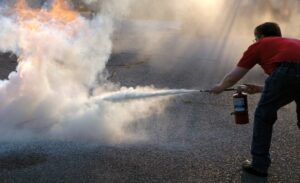Everybody knows how important a fire extinguisher is in case of an emergency. However, not many people realize that a single type of fire extinguisher does not work on all types of fires. Here’s a simple breakdown of the six types of fire extinguishers and everything you need to know about them.
There are many different types of fire extinguishers to effectively treat different classes of fire. Before we dive into the different types of fire extinguishers, it is essential to understand the six classes of fire. Ready to re-learn your ABCs?
- Class A – combustible material
- Class B – flammable liquids
- Class C – flammable gasses
- Class D – combustible metals
- Class E – electrical fires
- Class F – cooking fires
Now that we’ve covered the basics, let’s move on to the different types of fire extinguishers.
Type 1: ABC Powder Fire Extinguisher
This type of fire extinguisher is very handy in most situations due to its multi-purpose properties. An ABC powder fire extinguisher sprays a very fine chemical powder composed most commonly of monoammonium phosphate. This chemical acts as a blanket to suffocate and extinguish the fire very effectively.
Can you guess which class(es) of fire this fire extinguisher is designed for based on its oh-so-revealing name? Yes, you guessed it right, this one is perfect for use on class A, class B, and class C fires, which makes it the standard fire extinguisher for home use.
Type 2: Carbon Dioxide Fire Extinguisher
This is one of the cleanest fire extinguishers out there as it leaves no residue and requires no cleanup. It uses carbon dioxide to remove oxygen from the fire, leaving the fire to be effectively suffocated. This is ideal for class B fires that involve flammable liquids and on class E electrical fires.
Type 3: Wet Chemical Fire Extinguisher
Wet chemical is a new agent that extinguishes the fire by removing the heat of the fire triangle and prevents re-ignition by creating a barrier between the oxygen and the fuel elements.
This type of fire extinguisher is commonly used in class F fires involving cooking oils and fats. Additionally, they can also be used on class A fires (wood, paper, fabrics) and class B fires (flammable liquids).
Type 4: Water Mist Fire Extinguisher

This is the most versatile out of all the six different types. It uses a newer technology that works on most classes of fire. This type of fire extinguisher releases microscopic water molecules that fight the fire on various levels.
First, as the microscopic water molecules create a fog, the level of oxygen is decreased, leading to the suffocation of the fire. Second, the water also helps to reduce the temperature of the fire. And third, perhaps the most unique thing about this type is that since the water has been de-ionized (minerals are removed from the water), it can actually be used on electrical fires, as the de-ionized water will not act as a conductor, as well as on burning liquids/gases that a standard water extinguisher could not be applied to.
Therefore, it is safe and effective for use on class A, class B, class C, and class E fires.
Type 5: Foam Fire Extinguisher
As the name suggests, a foam fire extinguisher sprays a type of foam that seals the surface of the liquid, preventing flammable vapor from reaching the air and starving the fire of fuel.
This type can be used in class A and class B fires. It is most suited to extinguishing liquid fires such as petrol or diesel and can also be used on solids such as wood and paper.
Type 6: Clean Agent Fire Extinguisher
This eco-friendly fire extinguisher is stored in its liquid form. However, when it is sprayed and hits the air, it converts to its gas form which is non-conductive, safe to use when humans are present, leaves no residue, all while having a very short atmospheric lifetime.
The clean agent gas inside these fire extinguishers is halon. It extinguishes fire by reducing the oxygen levels and impeding the chain reaction. Since it is non-conductive and clean, it is ideal for rooms or properties filled with electrical and computer equipment. They are most commonly used for class B and class C fires.
Above are all the six types of fire extinguishers and everything you need to know about them. And if this is too overwhelming or brings you back to memorization in school (looking at you class clown) that’s what we’re here for. Now that you know which type to use for different classes of fires, make sure to also have regular inspections for your fire extinguishers. This way you will be well prepared if an emergency were to happen.
If you’re in need of our Fire & Life Safety services, contact us to get started. And if you want more helpful information like this from DynaFire, don’t forget to sign up for our bi-monthly newsletter so we can send them straight to your inbox.






